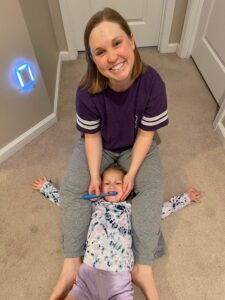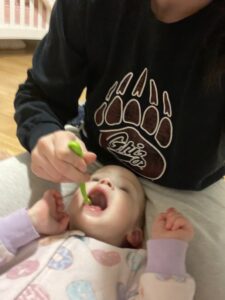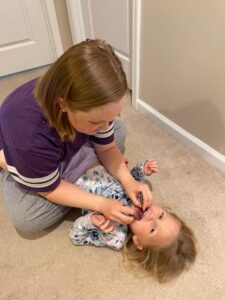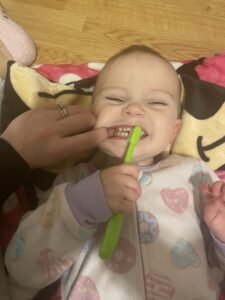Brushing Your Child’s Teeth
Did you know that brushing your child’s teeth can be fun! It can be challenging too, but there are so many things you can do to make it easier and get your kids excited to participate in this daily ritual. There are many reasons to start cleaning your child’s mouth from an early age. Cleaning your child’s teeth daily is important because healthy baby teeth hold the space for the adult/permanent teeth and help kids eat healthy foods more easily. Having healthy teeth builds confidence, and when there are no problems with your child’s teeth and no pain, they can concentrate in school better. It can also be a special bonding time for you and your child. Just know that kids will react differently to having their mouths cleaned. Believe me, I know since I experienced this with my daughters when I cleaned their teeth when they were little. I will tell you more about that later.

The best way to clean your child’s teeth is to start early, even before they have any teeth. What, even without any teeth? Yes, starting early helps children understand that it is an important part of taking care of themselves. Doing it every day will make it easier for everyone. I know some kids can be more challenging when trying to brush their teeth. They might cry or resist having you do it. It will get much easier with a few tricks and a little time. Please do not give up, I have seen many two-year-olds with cavities, and the more we can prevent that, the better. Like many things, it can just take time for them to get used to having you do it.
I have two kids who are entirely different. My older daughter was easy to brush and floss her teeth. She always cooperated and never fussed. My younger daughter was much more challenging when it was time for me to brush her teeth. I had to try many different ways of doing it. We sang songs, we did it in the bath, and I tickled her nose with her toothbrush, which made her laugh. Eventually, she realized that it was a daily thing, and she became more cooperative. Now this same daughter has a 22-month-old daughter. Her daughter, my granddaughter, was also very fussy at first and did not like it. But because I kept encouraging my daughter and explained about the importance of cleaning her baby’s teeth daily, she did not give up, and now they both enjoy the daily time together.

So how does one start? As soon as your baby is born, you can begin oral care. With infants, wipe their mouths with a washcloth. Try doing this while bathing your little one. For many babies, bath time is relaxing, making oral care easier. Start by wrapping a clean wet cloth dipped in warm water. Wrap it on your clean finger and then wipe the gums by gently massaging them. When you are starting out doing this with your baby, sing or hum a song as this will make it more enjoyable. Once they get their first tooth, you will want to start brushing with fluoride toothpaste. (see helpful ideas below for fluoride amounts). Have your baby’s head facing away from you.

It is important to add in between cleaning as well, especially if your child’s teeth are touching. You can use little floss sticks or wrap the floss around your fingers. Some people like using Gum Chucks. The Listerine Ultraclean Access Flosser has long handle that works great and is not expensive. Both products make it easier for anyone to floss. So how do you floss properly? Gently slide the floss between two teeth, curve the floss slightly by pulling it to curve slightly toward one of the teeth, and hug that tooth. Then go up and down, sliding along the tooth and under the gum 2-3 times. Then push toward the other tooth and do the same.

When it comes to brushing, it can be helpful to start on one side and move to the other. Brush tops and bottoms separately, so if you start with the top teeth, have your child say “eeeeeeee” and do all the upper cheek sides of those teeth. Then get the other sides of those teeth by having them say “ahhhhhhhh.” Then you can brush the chewing surfaces. Repeat on the lower. If you are having a tough time with your little one, do the best you can. Just doing it at the beginning builds consistency, and as time goes on, when they are more used to having you clean their teeth, then you can get everywhere more easily.

Children usually do not have the ability to brush their own teeth by themselves and do a good job. This is why the parent or guardian needs to do it for them. It is great to let them brush but know that you will also need to do it. Once your child can tie their own shoes, they should be ready to brush and floss independently, but still a good idea to watch, or better yet just be in there cleaning your teeth at the same time. That way you can be a great role model and see that they are getting the job done.

For older kids, you can use a disclosing tablet or liquid that shows where the plaque or germs are still on the teeth. Sometimes I have my patients use these once a week, but if there is a lot of plaque each time, you can use them more often. The red, purple, or blue shows where germs or bacteria are still on the teeth. You can buy these at most stores. There is a cool toothpaste called PlaqueHD that does something similar.
Video – Helping Kids to fight plaque with “Disclosing Tablets”
Reading books about taking care of your mouth can be helpful. If your child is hesitant, start by showing them how to brush the teeth/mouth of one of their favorite stuffed animals or dolls, and then have them try it too. Starting early with one or two teeth makes it easier for everyone and builds the foundation for a daily ritual that will help keep your child’s teeth and total body healthy.
Some helpful ideas:
- Have your child brush your teeth and tell them that they are helping you stay healthy just like you are helping them.
- Sing or hum while brushing. You can make up your own song, be silly if you like.
- Have the whole family brush together – Remember, kids do what they see you do
- Use an app with toothbrushing songs and videos to make it more fun
- Use a timer or an hour-glass timer
- Let them choose their toothbrush and paste flavor.
- Brush in the shower, good for any age
- Let toddlers hold a toothbrush while you are brushing with another one.
- Use enough fluoride toothpaste the size of a grain of rice for up to 3-years-old and a pea-sized amount for children ages 3 to 6 years.
- Have a contest to see who can get in the bathroom and their toothpaste on their brush first. This is good for those reluctant to transition to an activity.
- Teach your child not to swallow the toothpaste.
- Sit on the floor or sofa with your child’s head in your lap, facing away. you can straddle their arms and even wrap your legs around their body
- You can also try standing behind your child, they can look in the mirror, and you can keep their head steady with your other arm.
- For those kids who do not like any flavors, try Oranurse from Amazon. It still has fluoride but no flavoring.
- For flossing, flossers, Listerine long handled flosser or Gum Chucks
- Brushing apps: Top 5 Tooth Brushing Apps for Kids | Improve Your Child’s Smile (deltadentalia.com)